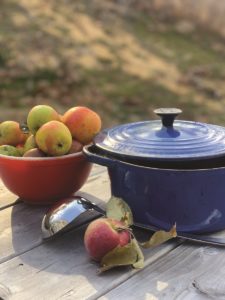When we first moved into our cottage in Truro several years ago, one of my first acts (after setting a great many mousetraps) was to scout out a place for an orchard. I had long fantasized about having one. Since they seemed to be the fruit that would grow most readily on the Cape, I chose apples. And since the only one tending them would be me, it was necessary to sort out the minimum number of trees required to constitute an orchard.
I polled friends who came up with numbers that were clearly wrong — 10, said one, or 24. I decided the right number was three and planted one Granny Smith and two Braeburns.
The blossoms that first spring were a joy, and I never tired of showing off my orchard. Visitors humored me.
Later, one of the trees died. But the other two grew through drought and storm and even allowed themselves to be uprooted and moved to make way for a construction project. No longer possessing the canonical number, I stopped calling the trees an orchard. But I waited for the pink-white blossoms each spring with no less anticipation.
Several years went by before my two apple trees produced anything edible. But once they did, the fruit was abundant and thus arose the problem of what to do with it. No greater wrong could be committed against a carefully tended fruit tree than to waste its offerings. Like some idealized American farmwife, I baked apple pies, made sauce, cooked pork with apples. My honey-thyme apple pie won second place at the Truro Ag Fair.
This spring, I tended my trees more lovingly than ever. Sad and frightened about the future of the world, I saw their blossoms as a sign of hope. During the summer plague and its accompanying drought, I watered and pruned and culled. I don’t know if my attentions mattered, but this fall’s harvest was particularly robust. I have had to work a little harder to make use of so many apples.

There have been tarts; sliced apples on sandwiches with cheddar cheese, onion, and mustard; composed salads with garden celery, sliced turnips, fall radishes, and apples. Our friend Ingrid has taken part of the harvest to make a wonderful cinnamon apple sauce. In a time when many people don’t have enough food to eat, waste seems a more egregious sin now than ever.
I only have a few dozen apples left. Just enough, after the feasting of Thanksgiving, to make an easy, nourishing soup. Because it will be soups, bubbling gently on the stove, that will get us through the winter that approaches.
I have some parsnips, leeks, and a potato on hand. I think the apples will balance the spiciness of the parsnips. I’ll add the warmth of ginger, curry, and coriander, and, to smooth things out, some coconut milk. Though you could move the seasonings in a more traditional direction with bay, thyme, and sage, perhaps rounding it out with a little cream. The recipe is simple, though it requires a bit of peeling and chopping, which I try to approach as a meditative practice.
Parsnip and Apple Soup
Serves 6 to 8
This soup wants a garnish for color. Mince fresh herbs, add diced raw apples or maybe a little sugarless apple sauce, toasted garlic slivers, a slice of baguette fried in some olive oil in a skillet, some roasted pepitas, or a swirl of plain yogurt.
1 Tbsp. butter
2 Tbsp. extra virgin olive oil
2 large leeks or 2 medium onions
1 to 2 Tbsp. minced ginger
2 tsp. minced garlic
1 Tbsp. tomato paste
1 tsp. coriander seeds
2 tsp. curry powder
½ cup dry white wine
1 lb. apples (ideally tart varieties)
1 lb. parsnips
1 large yellow or red potato
1½ quarts chicken (or vegetable) stock
1 can unsweetened coconut milk
Salt and cracked pepper
Prep the leeks, splitting them lengthwise, chopping them into half-moons, and cleaning them well. If you’re using the onion, dice it. Peel the ginger and chop it fine. Mince the garlic. Peel the parsnips and the potato and dice them. Peel, core, and dice the apple.
Heat the olive oil and butter in a heavy 4-quart pot over medium heat. Add the leeks or onions and cook until tender, about 6 minutes.
Add the ginger, garlic, tomato paste, coriander and curry to the pot, stirring, until fragrant, about one minute. Add the wine and continue to simmer, uncovered. Stir occasionally, until the liquid is largely evaporated, 2 to 3 minutes.
Add the chopped apples, parsnips, and potato. Add the broth and stir in 1½ teaspoons of salt. Bring to a boil, then reduce the heat and simmer, partially covered, until the vegetables are tender, about 30 minutes.
Puree the soup until completely smooth, using an immersion blender (or let it cool and use a standard blender). Return the soup to the stove, add the coconut milk, and heat through. Taste and correct the seasonings and serve with garnishes.



